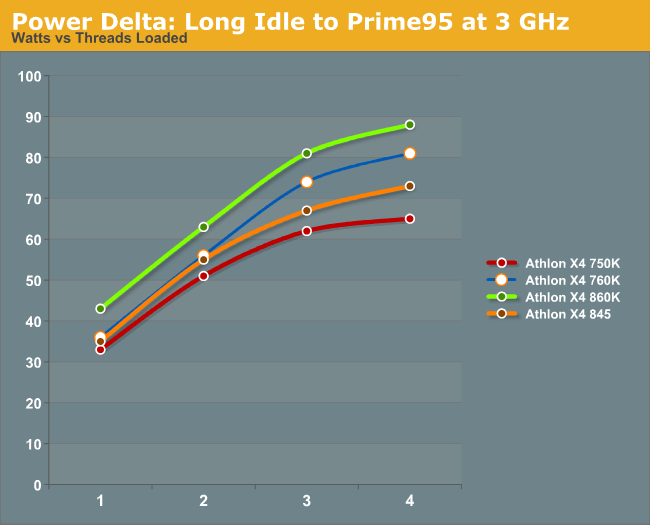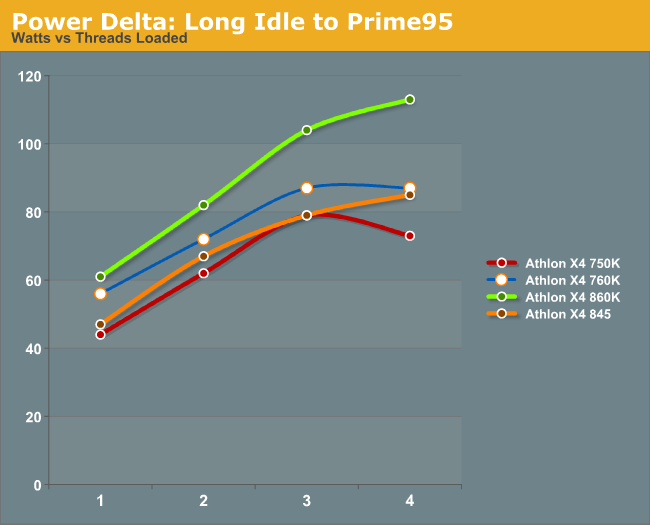AMD Carrizo Part 2: A Generational Deep Dive into the Athlon X4 845 at $70
by Ian Cutress on July 14, 2016 9:00 AM ESTPower Consumption
Power consumption was tested on the system while in a single MSI GTX 770 Lightning configuration with a wall meter connected to the power supply. This power supply is 80PLUS rated, and as I am in the UK on a 230-240 V supply, leads to ~75% efficiency > 50W, and 90%+ efficiency at 250W, suitable for both idle and multi-GPU loading. This method of power reading allows us to compare the power management of the UEFI and the board to supply components with power under load, and includes typical PSU losses due to efficiency.
Our Power Consumption tests have changed slightly since our last review as we are testing out new ways to represent the power used by the CPU and the system. The current three standard tests start with a system at long idle, meaning that the OS turns off the monitor and enters a lower power state without going into S3. We then move into a standard idle state on the desktop, with no software running but the desktop on display. The system is then moved into high performance mode, and we run a one-minute OCCT test to identify peak power consumption.
Due to extended requests, our power consumption numbers also use Prime95 to load the system. We use Prime95's peak power consumption mode, testing 1/2/3/4 thread consumption at the wall with our power meter. P95 hits the peak power relatively quickly, making this a straightforward test to include. For CPUs above 4 threads, we typically manage powers of two, half the CPU, and the full CPU to get an accurate picture.
For this review, we performed the power analysis for all four main CPUs at the 3 GHz frequency (using automatic voltage on the motherboard), as well as at stock frequencies. The values shown are delta values to the long idle power consumption, due to power delivery variations.
Generational Power Consumption at 3 GHz
All four processors have a 2-3W difference moving from a long idle to an idle state, however it is clear that our Carrizo CPU, which we stated is well outside its normal efficiency window at the beginning of this review, has a very good response during OCCT loading.

These results are within 3-4W of the full loading provided by Prime95 as well. If we analyze the per core jumps from moving up the threads using Prime95, there are some interesting numbers to pick out.

All the processors increase their power consumption by ~20W when both modules are loaded, when moving from 1 core loading to 2 core loading. When moving to 3/4 core loading, it is obvious that as both modules are already running at high frequency, a smaller amount of power is needed for each to enable the second thread.
Power Consumption at Stock
For those keeping track, we were not able to source identical TDP rated processors for this test. While the Carrizo based Athlon is 65W, the other processors are at the 95W/100W level. This makes total power consumption numbers relatively processional, and it becomes interesting looking into how close each processor gets to its TDP.
In our testing, the X4 845 seems to go beyond its 65W TDP, pushing almost another 9W through our power meter. This is only 8W away from the X4 750K, which should be 35W ahead. However, it would seem that for the X4 845, P95 draws an extra 15W compared to OCCT, but for the X4 750K, it draws 10W less, showing how difficult it can be to retain consistency. It is worth noting that TDP ratings are difficult to interpret in this way - the processors coming out of the fabs will have a statistical variation to their operating voltage, and this differs between samples. A good sample of a high TDP compared to a bad sample of a low TDP might seem to generate an interesting story, however without having access to several dozen units it can be strained to draw many conclusions.

Looking at the Prime95 core-loading numbers, we see a similar pattern to what happened at 3 GHz, despite the X4 760K getting the same power reading for 3/4 core loading and the X4 750K actually decreasing in power with four loaded threads.










131 Comments
View All Comments
Meteor2 - Saturday, July 16, 2016 - link
Thanks. It's a little more complex than i3/5/7-nxxx, where n increments by one each generation...TheinsanegamerN - Monday, July 18, 2016 - link
cariizo cores use the excavator design. excavator is core design, carrizo is the product line.Mokona512 - Saturday, July 16, 2016 - link
Please do this test with the Phenom II series in order to understand the generational IPC changes, and also providing a better point of reference for the Zen CPUs. The Zen claims are based on IPC changes from a CPU series where there was a drop in IPC.Ian Cutress - Monday, July 18, 2016 - link
I recently redid a Phenom X6 in Bench, though that's absolute chip perf and not exactly what you're looking for, but it's there :)Elizabeth king - Sunday, July 17, 2016 - link
Love spell came out tremendously, I highly recommending robinson.buckler @ yahoo . com for whatever problems you are experiencing in your relationship. He is the real deal. his love spell is absolutely wonderful.lwatcdr - Sunday, July 17, 2016 - link
I find AMDs low cost offerings really interesting but this just doesn't work for me. The Carrizo on the desktop just seems too limiting. I wish that AMD would update the AM1 line. It is so inexpensive and can support a good number of PCIe lots. For things like a NAS, media pc, or even a Chrome box/low end pc they seem like a really good choice except that they have not been updated in years.silverblue - Monday, July 18, 2016 - link
Puma+ is kind of like what Atom did with their earlier Atoms, a more efficient version of Jaguar. I'm surprised that they didn't just lock the turbo and produce these in Jaguar's place, unless it's not cost-effective to do so.The cat cores are dead now, which is a shame as we never got to see how a dual channel memory interface would improve their performance.
Eris_Floralia - Monday, July 18, 2016 - link
Another great review. I've translated all articles about Bulldozer architecture into Chinese in order to let people know why it didn't success. I believe that an eight-core Steamroller or Excavator would be competitive, but that never comes out.TheinsanegamerN - Monday, July 18, 2016 - link
it wont be competitive, excavator is still far behind intel is performance and in TDP, and cant overclock at all. And it is still 28nm and cache limited.AMD really needs to kill the bulldozer line. It is AMD's netburst.
Eris_Floralia - Monday, July 18, 2016 - link
well, with some adjustments, steamroller can still reach high frequency. with additional L3 and larger L2, the problem with excavator may get solved. I mean that latest bulldozer architecture can do better than present piledriver, but the improvement obiviously doesnt worth a try.